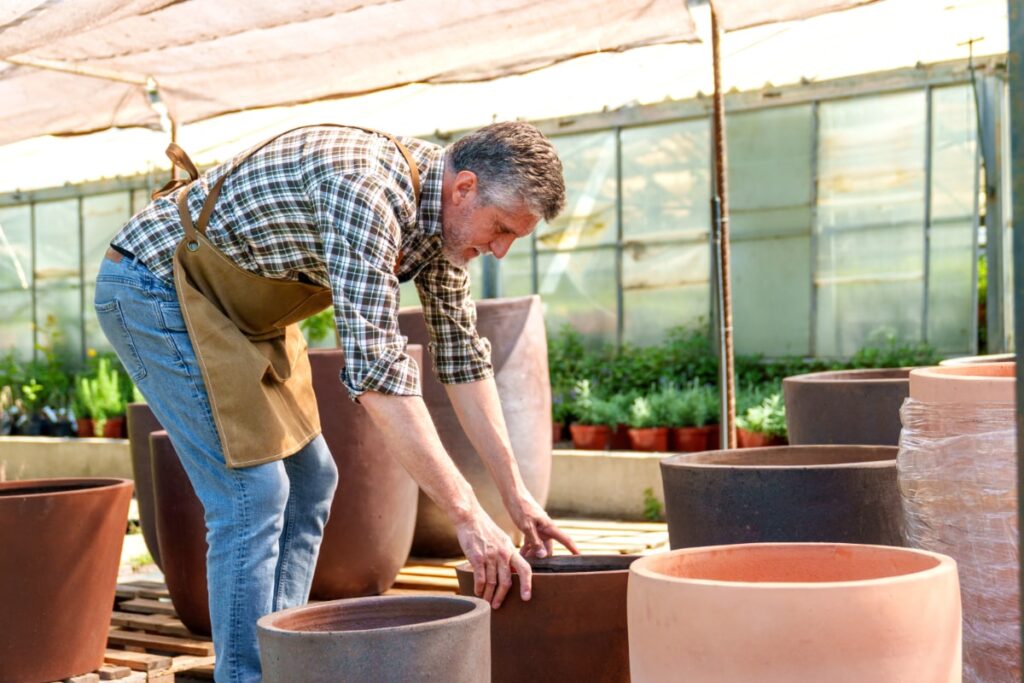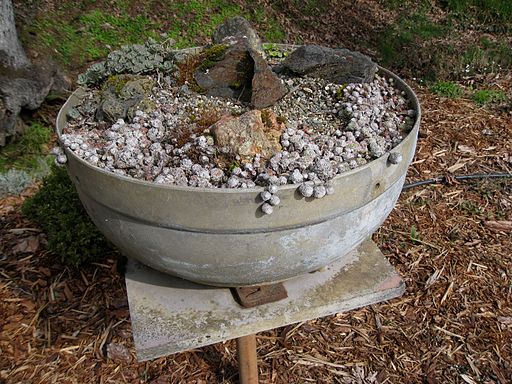Table of Contents
In today’s blog post, I show how to move heavy objects. I demonstrate a number of lifting techniques that will reduce your chance of causing back pain or a compression fracture. This is especially important for people with osteoporosis or osteopenia, and individuals with a history of low back pain.
Hire Someone
If you are unable to do a squat to move a heavy object, you should hire someone to do your heavy lifting. If you cannot do this or do not want to hire someone, follow the steps below.

How to Move Heavy Objects
For many of us, summer projects often involve moving heavy objects such as patio stones or rocks. During one of my many summer projects I thought it would be helpful to share a few tips that help me keep my spine happy:
Setup and Positioning
- When you move a heavy object, leverage the item up when possible.
- Use a sturdy stick under the corner of a rock to allow you to get a better grip and get it up a few inches.
- Get in as close as you can to the object you plan to lift.
- Widen your stance.
- Remember to take in a breath before you start and exhale as you tighten your pelvic floor and deep abdominals to brace your back.
- To protect your neck, keep you tongue relaxed and resting at the roof of your mouth.
Lift the Object
- As soon as you move the heavy object, support your forearms on your legs as a transitional position.
- Continue to push with your legs as you bring the object as close in to your body as you can safely do.
- Use a sturdy resting point in moving the object when possible.
- Avoid rotating your spine while holding the object.
- Move your feet in the same direction as the load.
- During the transition from point A to B keep the heavy objects as close to your body as you can and when possible rest it on your body.
- Keep the load against or very close to your torso reduces the load on your spine.
Return the Object
- When bringing the load back down, reverse what you did during the lift.
- If it is essential that the object be placed in an exact location, you can transition to a squat position with your forearms resting on your thighs. This is a more restful position for your back and allows you to fine tune the final resting position of your object.
- Plan the move and prepare the area to make it easier on your spine.

Learn to Move Heavy Objects. Incorporate Weekly Squats Into Your Life
I live in a climate that makes gardening accessible for about five months out of the year. During this short period there is a lot to get done. If you love to garden and plan to do it for many years to come, I encourage you to make squats a regular part of your exercise program.
Squats are one of the most functional exercises you can do. You cannot get on and off a chair without going into a squat. Make the squat exercise a regular part of your exercise program. It will help you when you move heavy objects and in many regular day-to-day activities. The squat has many significant benefits including strengthening your hip and spinal muscles and bones. It should become a regular exercise for any one concerned about the bone density in their femoral neck.
There are several types of squat exercises to choose from. Listed below are four squat exercises in order of challenge as they are presented in the Exercise for Better Bones program. Find one that feels comfortable for you and over time progress to a more challenging level.
Exercise Recommendations for Osteoporosis
It is really important to move heavy objects with proper form. However, you need to do more than that if you have osteoporosis. Exercise is an essential ingredient to bone health. If you have osteoporosis, therapeutic exercise needs to be part of your osteoporosis treatment program.
But what exercises should you do and which ones should you avoid? What exercises build bone and which ones reduce your chance of a fracture? Is Yoga good for your bones? Who should you trust when it comes to exercises for osteoporosis?
A great resource on exercise and osteoporosis is my free, seven day email course called Exercise Recommendations for Osteoporosis. After you provide your email address, you will receive seven consecutive online educational videos on bone health — one lesson each day. You can look at the videos at anytime and as often as you like.

I cover important topics related to osteoporosis exercise including:
- Can exercise reverse osteoporosis?
- Stop the stoop — how to avoid kyphosis and rounded shoulders.
- Key components of an osteoporosis exercise program.
- Key principles of bone building.
- Exercises you should avoid if you have osteoporosis.
- Yoga and osteoporosis — should you practice yoga if you have osteoporosis?
- Core strength and osteoporosis — why is core strength important if you have osteoporosis?
Enter your email address and I will start you on this free course. I do not SPAM or share your email address (or any information) with third parties. You can unsubscribe from my mail list at any time.
Conclusion to How to Move Heavy Objects
I hope that this blog has provided you with some tips on moving heavy objects safely and that it has encouraged you to stay strong over the fall and winter months. I wish you all many happy garden projects without the worry of straining your back. Follow the directions in this post, practice your squat and you will be better able to move heavy objects.
Activities of Daily Living
Visit my page dedicated to Activities of Daily Living.

Comments
August 9, 2016 at 10:30pm
Angel
Excellent video. Just what I needed to learn. I find myself bending over so much I wish there was a device that either stopped the forward bend or alerted me when I've started a forward bend. Are there such devices? I notice my forward after I'm in it. Thanks
August 10, 2016 at 7:56am
Richard Martin replies
Hi Angel:
Margaret has yet to find a product that she has used and recommends for posture correction. She encourages her clients to take an active role in their posture. She has a page dedicated to Perfect Posture:
http://melioguide.com/health-guides/perfect-posture/
August 12, 2016 at 7:41pm
Barb
Thanks so much. I hadn't even been aware that I was not moving my feet in the direction of the destination. I will try to remember all this now!
August 8, 2017 at 3:55pm
Ellen Solt
I love your videos. This is another one of your excellent videos, in which you effectively convey simple things that make a BIG difference for each of us participating in life -with education and encouragement to take the time to think, and to choose safe ways for our bodies and our backs, to do whatever we are working to accomplish. I learned something new today to protect my spine. I will be leaning my forearms on my thighs asap from this point forward, for my legs to do more of the lifting. Thank you!
From my experience, applying tape (that would hold a bandage in place) along each side of the spine can be a simple reminder to avoid bending forward; use this for short 'training' periods of time, i.e. when you are going to move a stone you usually don't move -or do something you know you tend to bend before realizing it -or doing an activity that is new to you. {Be sure to keep the tape on for a relatively short duration, as the tape can cause blisters if you bend too much while wearing it.}.
I love sharing ideas; I hope it can be a helpful tool for others! -Ellen
August 20, 2019 at 2:31pm
Cindy Stephenson
Excellent. Thanks very much.
August 27, 2019 at 11:16am
Leona Tichenor
Thank you. In the set up for squatting (or deadlifting) I have found I can fire the glutes more effectively if I widen stance and turn feet ever so slightly out. I suspect the best foot position varies from individual to individual probably based on natural differences in hip joint shape. Regularly practicing squatting helps fine tune the strongest stance (and safest) from which to work. The more I squat in the gym, the more instinctively I practice good posture in the yardwork.
September 8, 2019 at 3:26pm
Margaret Martin replies
HI Leona, Thank you for sharing your story. You are correct that we are all born with our own distinct shape of our hip joint, allowing us to rotate more internally (toes and femur in) or externally (toes and femur out). The wider stance is more stable in terms of balance. I wish you many more years of squatting and yard work.
Margaret
September 28, 2021 at 12:41pm
Lucy Van Baars
Hi Margaret, thank you so much for all the support and guidance you provide. It is so helpful and gives me some hope I can find a way of navigating living independently despite having severe osteoporosis.
I recently had what the consultant called a 'burst fracture' in my spine which was awful as I'm sure so many people living with osteoporosis know. I am now moving around a lot better and off the pain meds but very anxious about causing a new fracture to occur. This means I'm afraid to do certain activities, but have to do them as I live independently. I've watched your daily activities guide and found them helpful but I am wondering about my low down fridge. I live in a rented apartment and the fridge freezer I have puts the fridge on thd bottom half. I access my fridge severaltimes a day and need to use all the shelves. Unfortunatelyto reach into the bottom 3 shelves is s bit of a struggleand an action I'm aware may cause future micro fractures or worse. I have a grabber/reacher and this can be really helpful. But I have accidents. Am I able to reach into the back of the fridge at a height lower than my knees safely or should I try to get a fridge freezer that has the fridge on top? I use the freezer less often. (For information sakes, I'm 41yrs old).
Thank you so much in anticipation. Lu